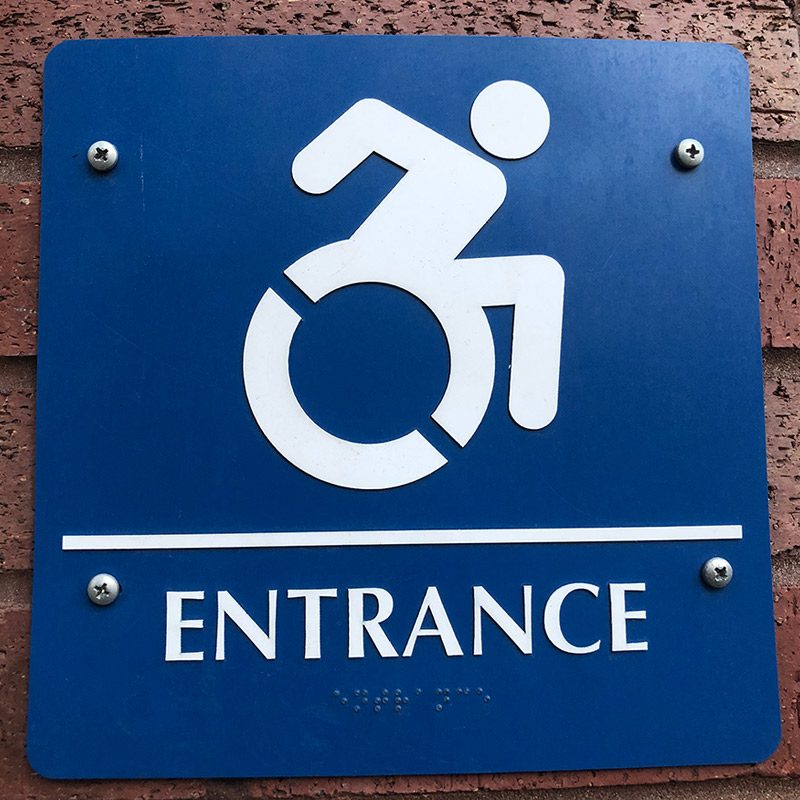The Effect of ADA Signs on Community Availability
The Effect of ADA Signs on Community Availability
Blog Article
Discovering the Trick Functions of ADA Indications for Improved Ease Of Access
In the realm of ease of access, ADA signs serve as quiet yet effective allies, making sure that areas are accessible and inclusive for individuals with disabilities. By incorporating Braille and responsive aspects, these indications break barriers for the visually damaged, while high-contrast shade plans and clear fonts accommodate varied visual demands. Their calculated placement is not approximate however rather a computed effort to promote seamless navigation. Past these functions lies a deeper story concerning the evolution of inclusivity and the ongoing commitment to developing equitable rooms. What much more could these indicators represent in our search of universal accessibility?
Relevance of ADA Compliance
Making sure conformity with the Americans with Disabilities Act (ADA) is vital for fostering inclusivity and equal gain access to in public rooms and workplaces. The ADA, enacted in 1990, mandates that all public facilities, companies, and transportation services fit people with handicaps, ensuring they delight in the exact same civil liberties and possibilities as others. Compliance with ADA requirements not just meets lawful commitments but additionally improves a company's online reputation by showing its commitment to diversity and inclusivity.
One of the key aspects of ADA compliance is the implementation of easily accessible signs. ADA indicators are made to ensure that people with disabilities can easily navigate through spaces and structures. These indicators have to stick to details standards relating to dimension, font style, color contrast, and placement to assure presence and readability for all. Effectively applied ADA signs assists get rid of barriers that people with handicaps usually run into, thereby advertising their self-reliance and self-confidence (ADA Signs).
Additionally, sticking to ADA regulations can minimize the threat of potential penalties and legal effects. Organizations that stop working to abide by ADA standards may encounter fines or suits, which can be both monetarily difficult and damaging to their public photo. Thus, ADA conformity is essential to cultivating an equitable setting for everyone.
Braille and Tactile Aspects
The consolidation of Braille and responsive elements into ADA signs embodies the principles of accessibility and inclusivity. These functions are crucial for individuals that are blind or visually impaired, enabling them to navigate public spaces with higher independence and confidence. Braille, a responsive writing system, is important in supplying written info in a layout that can be easily viewed via touch. It is generally put under the corresponding text on signage to make sure that people can access the information without visual support.
Responsive components prolong beyond Braille and include raised characters and icons. These elements are developed to be discernible by touch, allowing people to recognize space numbers, washrooms, exits, and other essential locations. The ADA sets details standards relating to the size, spacing, and positioning of these responsive aspects to optimize readability and make certain uniformity across various settings.

High-Contrast Color Design
High-contrast color design play a critical role in boosting the visibility and readability of ADA signs for individuals with aesthetic disabilities. These systems are necessary as they optimize the difference in light reflectance in between text and history, ensuring that indicators are easily noticeable, also from a distance. The Americans with Disabilities Act (ADA) mandates the usage of particular shade contrasts to suit those with restricted vision, making it an important facet of compliance.
The effectiveness of high-contrast colors lies in their capacity to stick out in imp source numerous lighting problems, consisting of dimly lit settings and locations with glow. Usually, dark message on a light background or light text on a dark history is used to achieve ideal comparison. As an example, black text on a yellow or white history offers a plain aesthetic distinction that aids in quick recognition and understanding.

Legible Fonts and Text Size
When taking into consideration the layout of ADA signs, the selection of understandable typefaces and appropriate text size can not be overemphasized. The Americans with Disabilities Act (ADA) mandates that typefaces have to be not italic and sans-serif, oblique, manuscript, very attractive, or of unusual form.
The size of the message likewise plays a critical role in availability. According to ADA standards, the minimum message height must be 5/8 inch, and it must enhance proportionally with seeing distance. This is especially important in public spaces where signage needs to be read quickly and accurately. Uniformity in text dimension adds to a natural visual experience, assisting people in navigating atmospheres effectively.
Moreover, spacing between lines and letters is integral to readability. Sufficient spacing protects against characters from showing up crowded, enhancing readability. By sticking to these criteria, developers can significantly boost ease of access, making certain that signage serves its desired purpose for all individuals, despite their visual abilities.
Reliable Positioning Techniques
Strategic placement of ADA signage is vital for maximizing access and guaranteeing compliance with lawful requirements. ADA standards state that signs must be placed at an elevation between 48 to 60 inches from the ground to guarantee they are within the line of sight for both standing and seated individuals.
Furthermore, signs must be placed beside the lock side of doors to allow very easy recognition before entry. This placement helps people find spaces and areas without blockage. In instances where there is no door, indications ought to be located on the nearby nearby wall surface. Consistency in indication placement throughout a facility boosts predictability, reducing complication and improving total individual experience.

Final Thought
ADA signs play an important function in advertising access by incorporating attributes that deal with the needs of people with handicaps. These see here now elements collectively foster an inclusive setting, highlighting the importance of ADA conformity in making sure equivalent gain access to for all.
In the realm of availability, visit this page ADA indications serve as silent yet powerful allies, guaranteeing that spaces are inclusive and navigable for individuals with disabilities. The ADA, enacted in 1990, mandates that all public facilities, employers, and transportation solutions suit individuals with handicaps, guaranteeing they enjoy the very same legal rights and chances as others. ADA Signs. ADA indicators are created to ensure that individuals with handicaps can quickly browse with areas and buildings. ADA guidelines stipulate that signs need to be placed at a height between 48 to 60 inches from the ground to ensure they are within the line of view for both standing and seated individuals.ADA signs play a crucial role in advertising availability by integrating features that address the needs of people with handicaps
Report this page